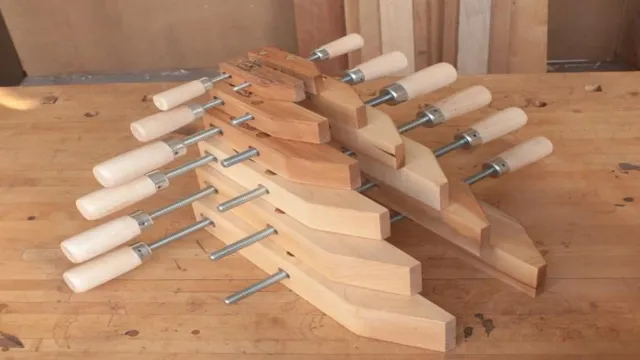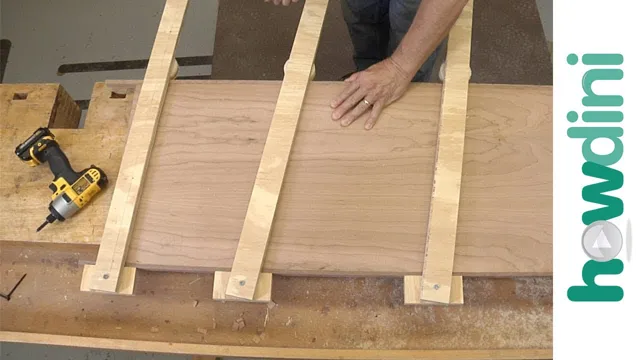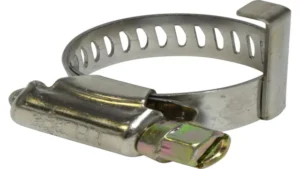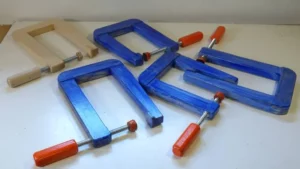Are you tired of buying expensive clamps for your woodworking projects? Perhaps you’re looking for a more economical option or just want to try your hand at making your own. Luckily, creating wood clamps is easier than you may think. With a few simple tools and materials, you can make your own wooden clamps that are just as effective as store-bought ones.
In this blog, we’ll go over the step-by-step process of creating wood clamps that will help you save money and expand your woodworking skills. So, roll up your sleeves and let’s get started!
Introduction
Are you looking for an easy and affordable way to make your own wood clamps? Look no further! With just a few basic tools and some simple steps, you can create your own sturdy and reliable clamps to use for all your woodworking projects. First, gather your materials, including hardwood strips, threaded rods, washers, nuts, and glue. Next, cut the strips to the desired length and drill holes for the rods to fit through.
Sand down any rough edges and assemble the clamps by threading the rods through the holes and securing them with nuts and washers. Finally, add glue to the joints and tighten the clamps down to ensure a strong hold. With these easy steps, you’ll have your own custom-made clamps in no time, ready to tackle any woodworking project you can dream up.
What are Wood Clamps?
Wood clamps are an essential tool for any woodworker. These versatile clamps are used to hold pieces of wood firmly in place while they are being joined together, glued, or drilled. They come in a variety of shapes and sizes, including C-clamps, bar clamps, pipe clamps, and hand screws.
The primary purpose of wood clamps is to exert pressure on the wood, ensuring that joints are tight and flush with one another. This pressure also helps to prevent any movement or shifting while the glue or screws are being applied. Ultimately, wood clamps are essential for ensuring precision and accuracy in woodworking projects, whether you’re building a small jewelry box or a large piece of furniture.

Why make your own?
Why make your own? Well, there are plenty of reasons why creating something from scratch can be more rewarding than just buying it. Making your own allows for complete customization, from choosing the ingredients to the size and shape of the final product. This level of control can even extend to the sustainability and ethical considerations of your materials.
Plus, the process of making something yourself can be quite therapeutic and satisfying, not to mention a great way to flex your creative muscles. Whether it’s baking a cake, crafting a piece of furniture, or even building your own home, the sense of accomplishment and pride that comes from creating something with your own two hands is truly priceless. So why settle for store-bought when you can make it yourself?
Materials Needed
If you’re a woodworking hobbyist or professional, making your own clamps can help save you money and ensure you have the exact size and strength you need for each project. To start making wood clamps, you’ll need a few materials. Firstly, you will need to purchase several lengths of hardwood, or you could use scrap wood pieces that are at least 18 inches long and 3 inches wide.
You will also need drill bits that are the same diameter as the threaded rod you plan to use, as well as a drill and wood glue. In addition, you will need nuts and washers that fit the threaded rod, and a saw or a table saw to cut the wood pieces to size. Once you have these materials, you’re ready to get started on building your very own wood clamps.
Wooden Blocks
If you’re looking to spark creativity in your child, it’s hard to go wrong with wooden blocks. These classic toys have been a childhood staple for generations, and for good reason. They’re versatile, durable, and endlessly entertaining.
All you need to get started are some wooden blocks! The first thing you’ll need is, of course, the blocks themselves. You can purchase pre-made sets from a toy store or online, but they can also be handcrafted for a more personal touch. You’ll need wood of a suitable quality, a saw, sandpaper, and some basic tools to create your own blocks.
Once you have your blocks, you might want to consider adding some embellishments to enhance your child’s creativity. You can paint them with non-toxic paints or even add patterns with stickers or stencils. You could also attach magnets to the blocks to add a new dimension to building.
Overall, wooden blocks are a simple and timeless toy that can provide hours of entertainment for both children and adults. With a little bit of creativity and some basic materials, you can create a wonderful toy that will last for years and encourage imaginative play.
Screws
When it comes to screws, the materials needed can vary depending on the intended use and environment. Some of the most common materials for screws include steel, stainless steel, brass, and aluminum. Steel is a popular choice for its strength and affordability, but it may be prone to rust if not coated or treated properly.
Stainless steel is ideal for outdoor or marine environments, as it is resistant to rust and corrosion. Brass is often used for decorative purposes due to its gold-like appearance and durability. Aluminum is lightweight and corrosion-resistant, making it a great choice for specific applications where weight is a concern, like in aerospace and automotive industries.
Selecting the right material for your screws can make all the difference in the stability and longevity of your project.
Wood Glue
When it comes to woodworking, one of the most important materials to have on hand is a good quality wood glue. But what exactly do you need to get started with this essential adhesive? First and foremost, you’ll need the glue itself! Look for a type that is designed specifically for woodworking, as this will provide the best holding power and durability. Next, you’ll need some tools to help you apply the glue, such as an adhesive spreader or brush.
These will allow you to evenly distribute the glue over your workpiece without making a mess. Finally, it’s a good idea to have some sandpaper and a damp cloth on hand to clean up any excess glue before it dries. With these simple materials, you’ll be well on your way to mastering the art of woodworking with wood glue as your trusty companion!
Steps for Making Wood Clamps
If you’re a DIY enthusiast or a woodworker, knowing how to make wood clamps can save you a lot of money. Wood clamps are essential tools when working with wood, and having a few of them around your shop can be a game-changer. To make a wood clamp, you’ll need a few tools, including a saw, drill, hammer, pliers, and sandpaper.
First, you’ll need to cut the jaws of the clamp from a piece of hardwood, like maple or oak. Then, you’ll need to drill a hole through the middle of each jaw to insert the threaded rod. Cut notches into the jaws so that the rod can be tightened, and then attach the handle to one end of the rod.
Finally, sand down the jaws and apply a coat of oil or wax to protect the wood. With a few simple steps, you can make your custom wood clamps that’ll work like a charm for all your woodworking needs.
Step 1: Cut the Wooden Blocks
If you’re interested in woodworking, you’ll love making these wood clamps. They’re incredibly useful and surprisingly easy to make. The first step is to cut the wooden blocks into the right shape.
You’ll need two blocks for each clamp, and they should be around six inches long by four inches wide. Use a saw to cut the blocks to the right size, taking care to make them as even as possible. You’ll also need to drill a hole through each block to fit a threaded rod later on.
Once you have the blocks cut and drilled, you’re ready to move on to the next step in making your wood clamps. Remember to take your time and be careful when handling the saw and drill. Safety should always come first when working with tools like these.
Step 2: Drill Holes for Screws
When it comes to making wood clamps, one crucial step is drilling holes for screws. This step is essential as it will ensure that your clamps function effectively and securely. To get started, mark the spot where you want to drill the holes on the wooden clamp and make sure they are evenly spaced.
Next, choose an appropriately sized drill bit that matches the size of the screw you plan to use. Make sure the drill bit is centered on the marked spot and drill straight down to the desired depth. It’s a good idea to use a clamp or vice to secure the wood in place while drilling to prevent any movement.
Once you’ve drilled all the holes, insert the screws and tighten them to hold the two pieces of wood together tightly. With the right size drill bit and proper technique, drilling holes for screws doesn’t have to be a difficult task. Just take your time and keep the drill bit steady, and you’ll have sturdy wood clamps that will last for years.
Step 3: Attach Wooden Blocks with Screws
Making wood clamps is a great way to add some personality to your woodworking projects while keeping them secure. In step three of this process, you will need to attach wooden blocks to your clamp with screws. These wooden blocks will serve as the jaws of your clamp, holding your workpiece in place during the woodworking process.
First, measure and mark the location on your clamp where you will attach the wooden blocks. Then, use a drill to create pilot holes where you will insert the screws. Next, align the wooden blocks with the pilot holes and use screws to secure them in place.
Be sure to choose screws that are long enough to provide sufficient hold but not so long as to damage your workpiece. With your wooden blocks properly secured, your clamp is now ready to use. By following these steps, you can create a custom wood clamp that will not only keep your workpieces secure but add some creative flair to your woodworking projects.
Step 4: Glue Jaws onto Blocks
Making wood clamps can be a fun and rewarding project for DIY enthusiasts. After cutting the blocks and jaws to size, the next step is to glue the jaws onto the blocks. This is an important step, as it will determine the clamping strength of your wooden clamps.
To ensure that the jaws are properly aligned and straight, use a clamp to keep them in place while the glue dries. You may also want to add some weight to the clamps to ensure a strong bond between the jaws and blocks. Once the glue has dried fully, you can remove the clamp and test the clamps to see if they hold securely.
Getting this step right is crucial to the success of your wooden clamps, so make sure to take your time and use the right glue and clamping techniques for best results. With a little patience and skill, you can create high-quality wooden clamps that will last for years to come. So why not give it a try and see the results for yourself?
Step 5: Use and Adjust Clamps as Needed
When it comes to making wood clamps, one of the most important steps is using and adjusting them as needed. It’s essential to have a good set of clamps to ensure the perfect fit of your pieces. These clamps should be tight enough to hold your wood in place while also allowing easy adjustments when necessary.
If there is any gap between the pieces of wood being clamped, simply use a shim to close it. Additionally, it’s crucial to make sure that the clamps are evenly distributed along the surface to avoid any distortion. Finally, make sure to regularly check the clamps and readjust them as needed to ensure the stability and quality of your project.
Whether you’re a beginner or a seasoned woodworker, using the right clamps can make all the difference in achieving a perfect finish.
Tips and Tricks
Woodworking enthusiasts know that clamps are essential to ensure proper jointing and gluing in their woodwork. However, store-bought clamps can be quite expensive, so a common solution is to make your own wooden clamps. To create your DIY wooden clamp, you will need a piece of hardwood that is at least 6 inches long, a 3-inch diameter spool, two 3/8 inch carriage bolts, and a couple of wing nuts and washers.
Begin by drilling two holes in the hardwood, about 1 inch apart and wide enough for the carriage bolts to fit through. Then, screw the spool onto one of the bolts and slide it into one of the holes. Next, insert the second bolt and attach the wing nut and washer to secure it in place.
Repeat the process on the other side, leaving enough space to slide in the material you want to clamp together. Now you have your very own homemade wooden clamp that works just as well as store-bought ones, minus the hefty price tag. So go ahead and start your wood project, knowing that you have a DIY clamp that you made with your own hands!
Choose Wood Blocks with Straight Grains
When it comes to buying wood blocks, it’s important to choose ones with straight grains. Why? Well, when the grains in the wood are straight, it means that the wood will be less likely to split or warp over time. Straight-grain wood is also easier to work with, as it won’t snag or tear as easily as wood with irregular grains.
So, how can you tell if a wood block has straight grains? Look at the end grain of the wood. If the growth rings run straight and parallel to each other, then the wood has straight grains. Additionally, you may want to avoid wood blocks with knots or other imperfections, as these can cause weakness in the wood and make it more prone to splitting.
By choosing wood blocks with straight grains and minimal imperfections, you’ll be able to enjoy your woodworking projects for years to come.
Keep Clamps Clean and Dry
When it comes to woodworking, clamps are an essential tool for ensuring precise and secure holds on your materials. However, like all tools, it’s essential to take care of your clamps properly. Keeping them clean and dry is crucial for maintaining their functionality and preventing rust and build-up.
After use, it’s vital to wipe down the clamp’s jaw with a dry cloth to remove any sawdust or debris that could damage the mechanism. Additionally, storing your clamps in a dry place, away from moisture, will prevent rust from forming on the metal. By taking these simple measures, you can ensure that your clamps remain in excellent condition and ready for use whenever you need them.
So, the next time you’re finished with your woodworking project, take a few moments to give your clamps the care they deserve, and they’ll thank you for it in their continued reliability.
Adjust Tightness as Needed
When it comes to adjusting tightness, it’s important to remember that one size does not fit all. Everyone’s body is different, and what feels comfortable and supportive for one person may not be the same for another. A good rule of thumb is to start with a moderate level of tightness and adjust from there based on your own comfort level.
Pay attention to any pain or discomfort and make adjustments accordingly. It’s also important to note that tightness can vary depending on the activity you’re doing. For example, you may want a tighter fit for high-impact exercise like running, while a looser fit may be more comfortable for low-impact activities like yoga or stretching.
Remember, the key is to listen to your own body and make adjustments as needed.
Conclusion
In conclusion, making your own wood clamps is not only possible, but it can also be enjoyable and rewarding. With a little bit of creativity and resourcefulness, you can save money while also customizing your clamps to fit your specific needs. All it takes is some basic materials, a few tools, and a can-do attitude.
So why settle for generic store-bought clamps when you can have your very own DIY creations that are as unique as you are? Go forth, my friends, and clamp like you’ve never clamped before!”
FAQs
What materials do I need to make wood clamps?
To make wood clamps, you will need wooden blocks, threaded rods, wingnuts, washers, glue, and clamping pads.
How do I assemble the wood clamps?
First, drill a hole through the wooden blocks. Insert the threaded rods through the hole and secure them with wingnuts and washers. Then, glue the clamping pads on the wooden blocks.
What is the ideal size for wood clamps?
The ideal size for wood clamps depends on the size of the projects you plan to tackle. For most woodworking projects, clamps that are at least 24 inches long are recommended.
Can I adjust the pressure on the wood clamps?
Yes, you can adjust the pressure on wood clamps by tightening or loosening the wingnuts on the threaded rods.
What are the advantages of making your own wood clamps?
Making your own wood clamps allows you to customize them to fit your specific needs, and it can save you money compared to buying commercial clamps.
How do I maintain my wood clamps?
To maintain your wood clamps, clean them after each use and store them in a dry place. Sand any rough spots or nicks on the clamping pads.
Can I use my wood clamps on other materials besides wood?
Yes, you can use wood clamps on other materials such as metal, plastic, or ceramics, as long as the clamping pads are covered in a material that won’t damage the surface.






